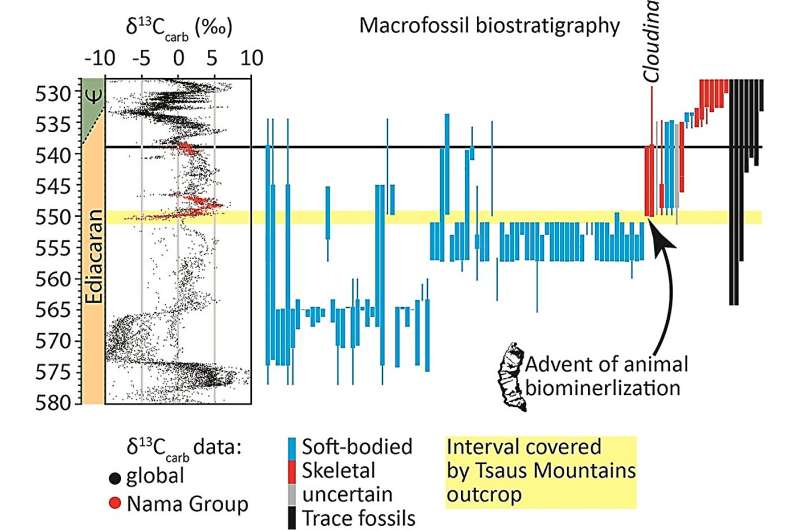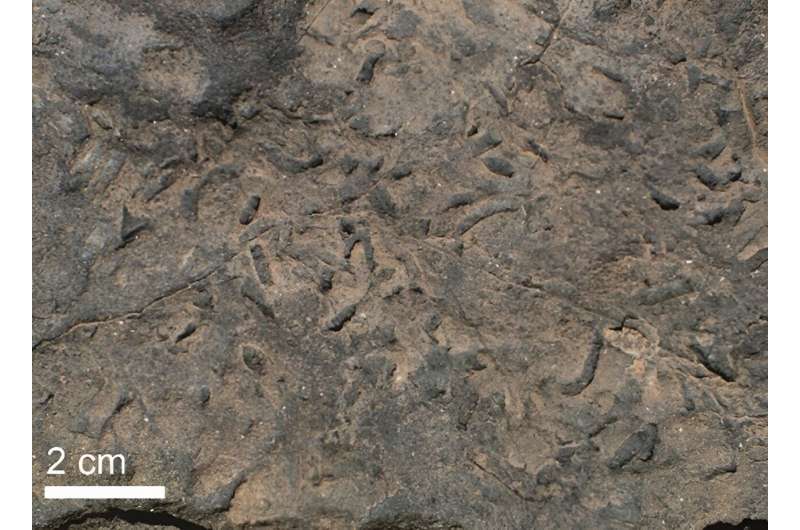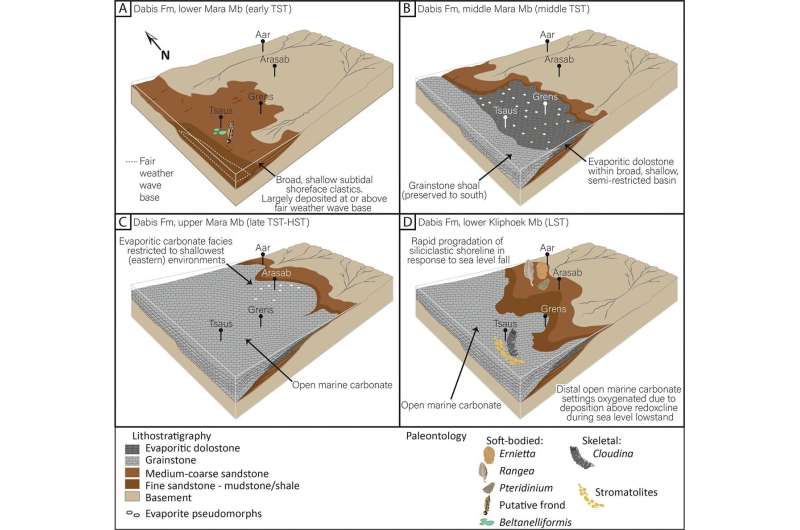September 24, 2023 feature
This article has been reviewed according to Science X's editorial process and policies. Editors have highlighted the following attributes while ensuring the content's credibility:
fact-checked
peer-reviewed publication
trusted source
proofread
Ediacaran fossils reveal origins of biomineralization that led to expansion of life on Earth

Life on Earth began from a single-celled microbe, while the rise to the multicellular world in which we live arose due a vital chemical process known as biomineralization, during which living organisms produce hardened mineralized tissue, such as skeletons. Not only did this phenomenon give rise to the plethora of body plans we see today, but it also had a major impact on the planet's carbon cycle.
Fossil skeletons of cloudinids (Cloudina), tubular structures comprised of carbonate cones up to ~1.5cm in length, have been found in Tsau Khaeb National Park, Namibia, dating back to 551–550 million years ago in the Ediacaran (~635–538 million years ago). Dr. Fred Bowyer, from the University of Edinburgh, and colleagues aimed to use these fossils to define the location, timing and reason for why biomineralization initiated on Earth and the magnitude of its impact.
New research published in Earth and Planetary Science Letters combines sediment analysis with geochemical data in the form of carbon and oxygen isotopes (the same element with different atomic masses) from limestones in the Kliphoek Member, Nama Group. The research team suggest this rock was once deposited in a shallow sea during a lowstand before a period of transition to open marine conditions.
The Nama Group of rocks are considered some of the most important for understanding the radiation of life on Earth into the Cambrian (~538–485 million years ago), colloquially termed the "Biological Big Bang."

During fieldwork in Namibia, the bedding planes between successive rock units reveal the wonders of life's history through ichnofossils, the traces of ancient activity but not expressly preserving the organism's remains. Dr Bowyer suggests these are structures created by soft-bodied microbes, occurring in the lower part of the study site (Mara Member) prior to biocalcification. Above this, the research team began to see the first signs of Cloudina in the Kliphoek Member, distinctive conical fossils with cone structures nested within each other.
Geochemical analyses of the calcium carbonate limestone rocks in which the fossils occur reveal the isotopic signature of the carbon (the ratio of lighter 12C to 13C) and oxygen (16O to 18O) incorporated into the molecular structure, and therefore conditions of the marine environment, as well as the planet as a whole.
For example, warmer global temperatures encourage evaporation of seawater including the isotopically lighter 16O, leaving the ocean enriched in heavier 18O to be incorporated into the carbonates and generating a positive 18O signal in the dataset.
Meanwhile, carbon isotopes are impacted by photosynthesis, respiration and upwelling zones making them slightly more complex, but generally greater ocean productivity by photosynthesizing organisms uses the lighter 12C, leaving the ocean enriched in 13C (positive signal).
The Namibia dataset possesses carbonate-derived 12C/13C ratios of −7.24‰ (parts per thousand) to +2.91‰ and 16O/18O ratios from −12.14‰ to −0.78‰, increasing up the stratigraphic section, while Cloudina-bearing units have a relatively lower mean 12C/13C ratio of -1.19‰ and oscillating 16O/18O ratios. Dr Bowyer and colleagues suggest the lower 12C/13C ratio and elevated 16O/18O ratio are characteristic of a semi-restricted environment, connected to the ocean but more closed off from the open marine conditions.

Therefore, the geochemical data indicates Cloudina originated in a low oxygen environment with periods of notably higher oxygenation and that it was not a case of sustained oxygenation that resulted in the appearance of skeletonization. However, the research team suggest particularly high carbonate concentrations in the ocean were necessary to supersaturate the ambient environment from which Cloudina formed their calcified structure.
This resulted from a period of marine transgression, when the shoreline moved landward so that the study site experienced shallow intertidal conditions in an evaporite basin for the Mara Member, before sea level rose once more with the deposition of sandstones and calcitic sediments in the shallow open marine conditions of the Kliphoek Member.
During subsequent sea level fall, these open marine carbonates were deposited above a redoxcline, a layer which sees significant differences in water oxygenation above and below it, allowing for Cloudina biomineralization to occur.
Alongside previous research, this study supports the suggestion that Cloudina and similar microbiota were opportunistic colonizers of short-lived periods of respiration during oxygenation in otherwise relatively anoxic conditions, combined with oscillations in sea level. Consequently, the evolutionary novelty of skeletonization may have actually been driven by the instability of the marine environment.
More information: Fred T. Bowyer et al, Constraining the onset and environmental setting of metazoan biomineralization: The Ediacaran Nama Group of the Tsaus Mountains, Namibia, Earth and Planetary Science Letters (2023). DOI: 10.1016/j.epsl.2023.118336.
Journal information: Earth and Planetary Science Letters
© 2023 Science X Network





















